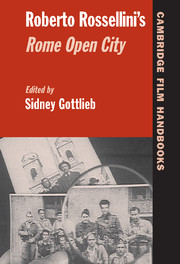Book contents
- Frontmatter
- Contents
- Acknowledgments
- List of Contributors
- Introduction: Open City: Reappropriating the Old, Making the New
- 1 Rossellini, Open City, and Neorealism
- 2 The Making of Roma città aperta: The Legacy of Fascism and the Birth of Neorealism
- 3 Celluloide and the Palimpsest of Cinematic Memory: Carlo Lizzani's Film of the Story Behind Open City
- 4 Diverting Clichés: Femininity, Masculinity, Melodrama, and Neorealism in Open City
- 5 Space, Rhetoric, and the Divided City in Roma città aperta
- 6 Mourning, Melancholia, and the Popular Front: Roberto Rossellini's Beautiful Revolution
- REVIEWS OF OPEN CITY
- Filmography
- Select Bibliography
- Index
1 - Rossellini, Open City, and Neorealism
Published online by Cambridge University Press: 09 February 2010
- Frontmatter
- Contents
- Acknowledgments
- List of Contributors
- Introduction: Open City: Reappropriating the Old, Making the New
- 1 Rossellini, Open City, and Neorealism
- 2 The Making of Roma città aperta: The Legacy of Fascism and the Birth of Neorealism
- 3 Celluloide and the Palimpsest of Cinematic Memory: Carlo Lizzani's Film of the Story Behind Open City
- 4 Diverting Clichés: Femininity, Masculinity, Melodrama, and Neorealism in Open City
- 5 Space, Rhetoric, and the Divided City in Roma città aperta
- 6 Mourning, Melancholia, and the Popular Front: Roberto Rossellini's Beautiful Revolution
- REVIEWS OF OPEN CITY
- Filmography
- Select Bibliography
- Index
Summary
Neorealism has been a source of inspiration and often heated debate, particularly in Italy but worldwide as well, for several generations of filmmakers, critics, theorists, and even politicians. It is one of the key interpretive contexts for Open City - and vice versa: the film made significant contributions to the articulation of neorealism and gives us important insight into Rossellini's particular involvement in this heterogenous and collaborative movement - or school, or genre, or cohort, or attitude, as it is variously described. school, or genre, or cohort, or attitude, as it is variously described. At the same time, Open City is typically viewed in the light of definitions of neorealism that fit the film only imperfectly, and foreground some aspects of it at the expense of excluding other equally important ones. The connection between Open City and neorealism is thus both inevitable and problematic, enlightening and potentially darkening. In order to understand some of the complexities of this connection, it may be helpful to briefly summarize key aspects of neorealism, as it is usually and in some respects as it is not usually defined, consider a few specific comments by Rossellini that help clarify his take on neorealism, and briefly examine why we chould look both to and beyone the usual denotations and connotations of neorealism to appreciate the full range of Open City's artistry and achievement.
Although it would in some ways be truer to the spirit of neorealism to describe it in a decentered cascade of phrases, keywords, and concepts that have been generated through the years by its various practitioners, theorists, and witnesses, for the sake of clarity, it may be useful to organize a definition around several categories.
- Type
- Chapter
- Information
- Roberto Rossellini's Rome Open City , pp. 31 - 42Publisher: Cambridge University PressPrint publication year: 2004
- 1
- Cited by

